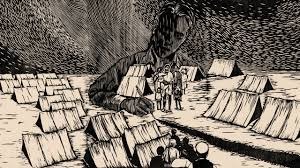Parul Sehgal in The New Yorker:
 Before it was an edict, and a death sentence, it was a rumor. To many, it must have seemed improbable; I imagine my grandmother, buying her vegetables at the market, settling her baby on her hip, craning to hear the news—a border, where? Two borders, to be exact. On the eve of their departure, in 1947, after more than three hundred years on the subcontinent, the British sliced the land into a Hindu-majority India flanked by a Muslim-majority West Pakistan and East Pakistan (now Bangladesh), a thousand miles apart. The boundaries were drawn up in five weeks by an English barrister who had famously never before been east of Paris; he flew home directly afterward and burned his papers. The slash of his pen is known as Partition.
Before it was an edict, and a death sentence, it was a rumor. To many, it must have seemed improbable; I imagine my grandmother, buying her vegetables at the market, settling her baby on her hip, craning to hear the news—a border, where? Two borders, to be exact. On the eve of their departure, in 1947, after more than three hundred years on the subcontinent, the British sliced the land into a Hindu-majority India flanked by a Muslim-majority West Pakistan and East Pakistan (now Bangladesh), a thousand miles apart. The boundaries were drawn up in five weeks by an English barrister who had famously never before been east of Paris; he flew home directly afterward and burned his papers. The slash of his pen is known as Partition.
A tidy word, “Partition.” Amid what the Punjabis call the raula—the “uproar”—the region convulsed with violence, Hindus and Sikhs on one side, Muslims on the other. Entire villages were massacred. Neighbors turned on each other. It’s estimated that a million people were killed, and that seventy-five thousand women and girls were abducted and raped, a third of them under the age of twelve. Millions of refugees fled in one of the largest and most rapid migrations in history. “Blood trains” crisscrossed the fresh border, carrying silent cargo—passengers slaughtered during the journey. Cities transformed into open-air refugee camps, like the one in Delhi to which my grandmother escaped in the night, alone with her children, feeding the baby opium, the story goes, so he would not cry.
More here.
